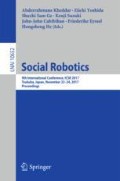Abstract
Autism Spectrum Disorder (ASD) is a neurodevelopmental disorder that is characterized by impaired social interactions and restricted, repetitive behaviors. Children who are considered to be within the spectrum tend to lack the social interaction, facial processing, and emotion recognition and implementation skills that typically developing children possess. These impairments inhibit positive social interactions, relationship building, and effective communication, which could potentially lead to distress and frustration for the child. This study focuses on developing a system to teach five of the six universal emotions. Therefore, we created an emotional gesture set to be performed on a pair of humanoid robot platforms, the NAO and the Mini Darwin. As a step towards reaching that goal of teaching and assessing children with ASD, we conducted a pilot study with able-bodied adults to validate that the gesture set created was easily recognizable. In this pilot study, we asked 137 able-bodied adult participants to watch the system perform gestures that associated to emotions. Then, we asked them to identify the emotion that the system was attempting to portray. Gestures achieved recognition rates ranging in values, with a maximum rate of 96% for sadness and a minimum rate of 57% for happiness.
Access this chapter
Tax calculation will be finalised at checkout
Purchases are for personal use only
References
Friedenberg, J., Silverman, G.: Cognitive Science: An Introduction to the Study of Mind, 2nd edn., vol. 3. Sage, Thousand Oaks (2012)
Coasta, S., et al.: An approach to promote social and communication behaviors in children with Autism Spectrum Disorders: robot based intervention. In: IEEE International Workshop on Robot and Human Interactive Communication, pp. 101–106 (2011)
Kozima, H., et al.: Interactive robots for communication-care – A case-study in autism therapy. In: IEEE International Workshop on Robot and Human Interactive Communication, pp. 241–34 (2005)
Robins, B., Dautenhahn, K.: The Role of the Experimenter in HRI research – A case study evaluation of children with autism interacting with a robotic toy. In: Proceedings of Robot and Human Interactive Communication, ROMAN, pp. 646–651 (2006)
Kim, E., et al.: Social robots as embedded reinforcers of social behavior in children with autism. J. Autism Dev. Disord. 43, 1038–1049 (2013)
Malik, N., et al.: Feasibility of using a humanoid robot to elicit communicational response in children with mild autism. In: International Conference on Mechatronics (2012)
Tapus, A., et al.: Children with autism social engagement in interaction with Nao, an imitative robot: a series of single case experiments. Interact. Stud. 13(3), 315–347 (2012)
Park, H., et al.: Using a shared tablet workspace for interactive demonstrations during human-robot learning scenarios. In: Proceedings of Robotics and Automation (2014)
Langner, O., et al.: Presentation and validation of the Radbound Faces Database. Cogn. Emot. 4(8), 1377–1388 (2010)
So, W., et al.: Using robot animation to promote gestural skills in children with autism spectrum disorders. J. Comput. Assist. Learn. 32, 632–646 (2016)
SoftBankRobotics.com: Find out more about NAO. SoftBank Robotics (2017)
Robotis: ROBOTIS Darwin-Mini humanoid robot, Product Code-RB-Rbs-157. Robotshop.com (2017)
Howard, A., Zhang, C., Horvitz, E.: Addressing bias in machine learning algorithms - a pilot study on emotion recognition for intelligent systems. In: IEEE Workshop on Advanced Robotics and its Social Impacts (2017)
Jones, C., et al.: A multimodal approach to emotion recognition ability in autism spectrum disorders. J. Child Psychol. Psychiatry 52(3), 275–285 (2011)
Lin, L.: A concordance correlation coefficient to evaluate reproducibility. Biometrics 45, 225–268 (1989)
Acknowledgments
Partial support for this research was provided by the Linda J. and Mark C. Smith Endowed Chair in Bioengineering.
Author information
Authors and Affiliations
Corresponding author
Editor information
Editors and Affiliations
Rights and permissions
Copyright information
© 2017 Springer International Publishing AG
About this paper
Cite this paper
English, B.A., Coates, A., Howard, A. (2017). Recognition of Gestural Behaviors Expressed by Humanoid Robotic Platforms for Teaching Affect Recognition to Children with Autism - A Healthy Subjects Pilot Study. In: Kheddar, A., et al. Social Robotics. ICSR 2017. Lecture Notes in Computer Science(), vol 10652. Springer, Cham. https://doi.org/10.1007/978-3-319-70022-9_56
Download citation
DOI: https://doi.org/10.1007/978-3-319-70022-9_56
Published:
Publisher Name: Springer, Cham
Print ISBN: 978-3-319-70021-2
Online ISBN: 978-3-319-70022-9
eBook Packages: Computer ScienceComputer Science (R0)

